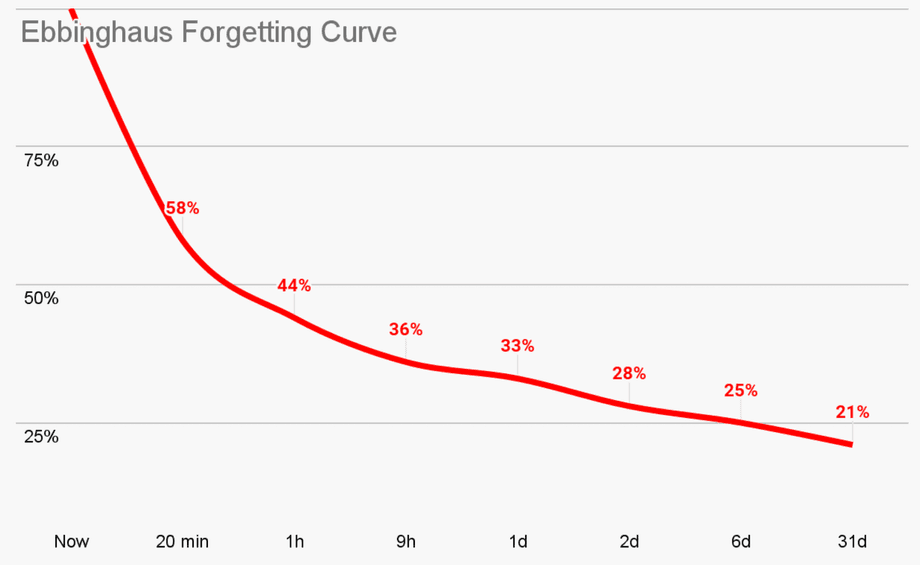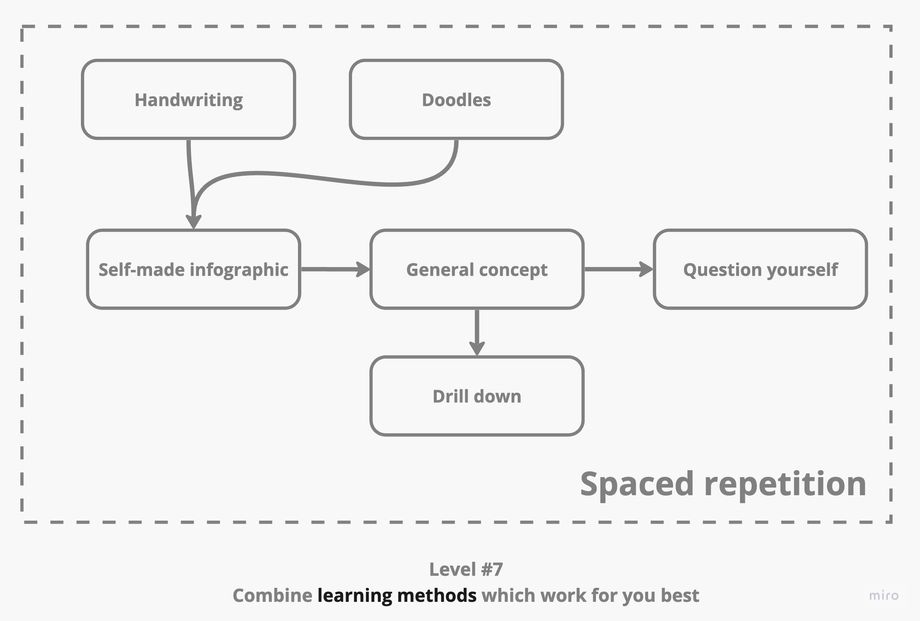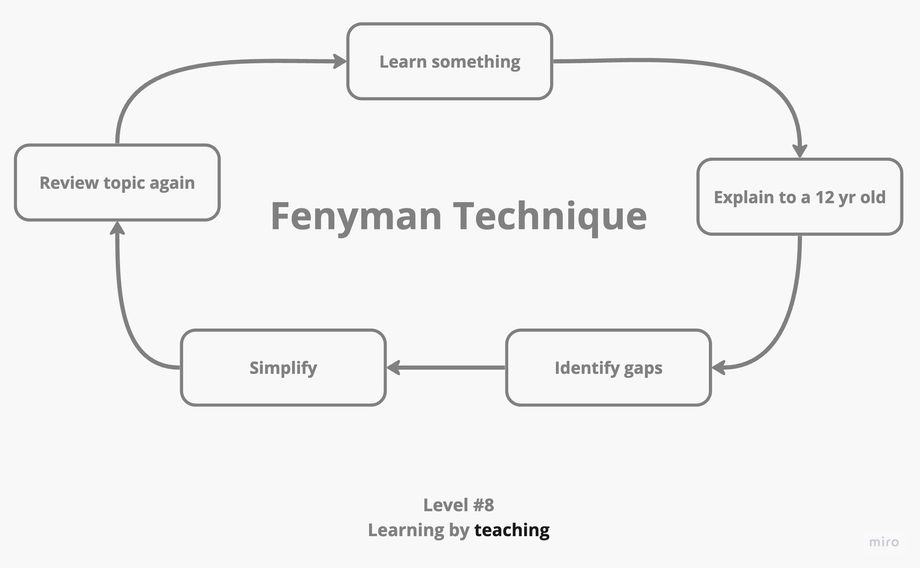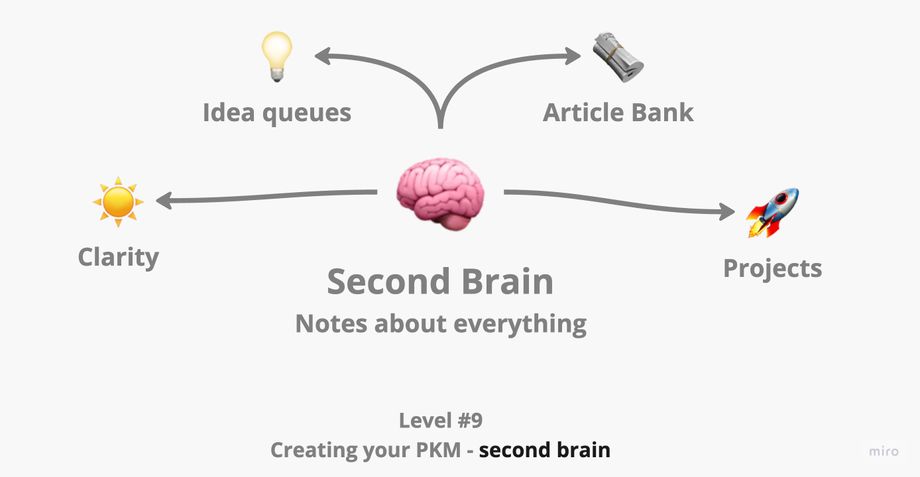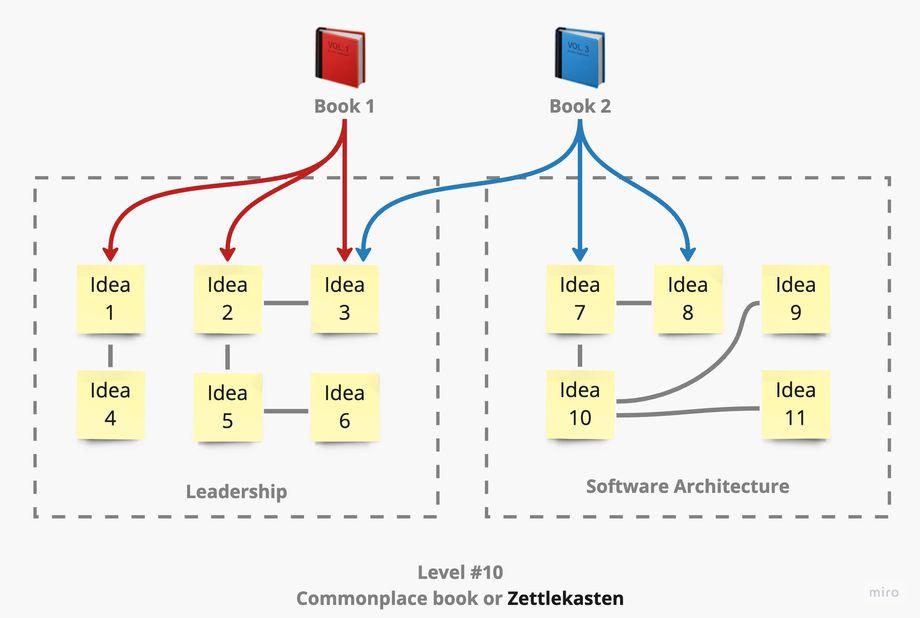Evolution of my learning methods, part #3
Welcome to the third and last part of my opinionated series about different levels of awareness of the learning process and how effective it is.
- Part 1 - levels 0 to 3 - was focused on motivation and habits, our drivers and the topic of discipline;
- Part 2 - levels 4 to 6 - was focused on deliberateness learning just-in-time vs learning just-in-case as well as quality resources of knowledge, including newsletters;
- Part 3 (this one) - levels 7 to 10 - is focused on increasing knowledge retention, or how can we increase information stickiness, covering topics of making notes and repetition;
Without further do, let’s dive in.
Level 7 - Discover how you learn best
After implementing levels 1 to 6 from previous posts, you are now reading a lot of high-quality material and you do it with discipline! 👏 Congrats! Life is good.
Some time has passed. Maybe you can review your actions and notice that you’ve read 12 technical books last year - woah! That’s fantastic. With pure satisfaction and pride, you can tap yourself on the shoulder now… 😉
But one day someone comes to you with a question and you don’t exactly know the answer… but at least you remember where to look - something related to that topic was placed in one of the books on the shelf that you’ve read two years ago. You quickly grab it, only to find out that you cannot locate the piece of information you’re looking for.
Even worse, you realize that there are a lot of insights in this very book you hold in your hands which you’ve missed? Or you don’t remember at all. Or maybe your experience has evolved and now you have a different perspective?
That’s the Ebbinghaus Forgetting curve in real life. How fast do you think we keep forgetting what we’ve learned?
- We forget about 40-50% of what we’ve learned after… an hour!
- Around 65% is gone after 24 hours;
- More than 80% is gone after 4 weeks;
Isn’t this insane?
Stopping the forgetting madness is exactly what I’ve meant before by increasing retention of learning. If we won’t do anything about this topic, just ignore it, what’s the point in reading 12 technical books a year? Now you may also realize how futile JiC learning can be…
I understood around 10 years ago that I’ve accidentally discovered a process which works for me way better than anything else. I was tempted to brag that “I can literally learn any topic you throw at me”... 😂 but seriously - I battle-tested it during my studies. Not only I’ve finished three different technical majors with highest possible grade, I was also doing three semesters at the same time. That meant a lot of exams in a short time.
So what did it look like?
- I’d buy a lot of paper.
- I’d read the studying material from A to Z.
- I’d made a break, around 10-30 minutes. In some cases - a nap.
- I took the piece of paper, and I would write from my head in my own words:
- A general concept of what the studying material is all about - as general as possible - if I couldn’t do it that meant I didn’t understand the studying material even roughly.
- I tried to write in my own words the structure of the content - imagine chapters in a book as an example.
- Then I was drilling down into each chapter writing more contents and sub-chapters, sometimes writing questions to myself in the process and drawing schemes or diagrams.
- In multiple areas when I wouldn’t remember what was supposed to be there, I would circle this for future reference next to the questions.
- That produced a lot of pieces of paper which were barely readable, full of doodles, questions, circles, and arrows.
- Afterwards I would take studying material once again and I would look for answers to my questions on the side, circle areas and anything that I didn’t fully grasp or understand. This time reading the material was enlightening, because I really made myself curious by questioning myself! In some cases I’ve needed to take another studying material to fully answer questions which I had. I was going deep, really studying, not just consuming and hoping for the best.
- Next day I’d do a similar exercise, usually it was way faster and easier, questions were also deeper and finding answers was not that quick.
- You can summarise this technique as spaced repetition combined with the creation of my own notes (common knowledge says that creating your own cheat sheets is a good learning method) which is also handwritten (there are proofs that handwritten notes last longer).
Later I discovered a book about different ways of learning (Radek Kotarski - Włam się do mózgu - so far only in Polish) which displayed plenty of different but similar methods of studying with the material. I bet you know many of them:
- Using flashcards;
- Creating your own edugraphics;
- Mind palace;
- Knowing which type of VARK (visual, auditory, reading/writing, kinesthetic) you are;
Level 8 - Teaching others
Richard Feynman was a famous theoretical physicist, named by Bill Gates “the best teacher I never had”, also known for very effective learning method called “The Feynman Technique”. It goes like this:
- Try to learn something about any topic;
- Explain it to a 12-year-old;
- Reflect on it, simplify it, improve it;
- Organize and review with someone;
Indeed, it’s widely known that teaching others is a fantastic way to learn (it’s called learning by teaching) and discover new facts. Many of us, software engineers have heard about rubber duck debugging. It’s a fantastic phenomenon when we cannot find a solution to a problem but as soon as we need to explain it to our colleague, when we vocalize it for the first time, our chaotic thoughts align and… we find the answer ourselves. Our colleague didn’t need to say a word, maybe just raise an eyebrow.
Have you heard about plastic platypus learning? Same thing, just less known! Feynman understood that we don’t really need a real 12-year-old present to patiently listen to us babbling all the time, the act of vocalizing our thoughts and simplifying them is enough to help us in learning.
Some of us, brave engineers attempted to perform tech talks during meetups. I bet that those who did felt that they really learned or prepared very well for their presentations. Not only because of stress or frequent repetition which also occurred and helped but mainly because they needed to structure a talk and simplify it for the audience. It’s funny that the areas in such talks which sound fuzzy or difficult to understand for guests are often the ones also less understood by the speaker… 😉
Additionally, maybe you don’t know it, but I’m writing my blog for a similar purpose. Making a habit of writing and explaining topics which I’ve learned is a reinforced loop and enforcement on myself to simplify concepts playing pong in my head.
Finally, mentoring is a fantastic way to apply this learning method and challenge yourself. It’s difficult because it enforces us not only to simplify topics as Feynman suggests but for many professionals it requires growing a special kind of patience and going back to a mindset of a more junior colleague. “The priest forgets that he was a clerk…” could fit here 😃. Keep in mind that mentoring is also a spaced repetition exercise on fundamentals. All in all, it’s worth it.
We can apply learning by teaching even through small, daily actions. During code review, you may want to explain a certain topic to another engineer and you’ll realize during writing a comment that you’re uncertain about it. That may lead you to do a short research (maybe to prove your point or gain some Internet authority behind you 😉) but there is a chance that through this short action, you’ll clarify the concept for yourself, and next time - you won’t need to search. If you think that some concepts are too difficult to explain simply, visit r/explainlikeimfive/!
Level 9 - PKM system with random notes
Once you go far enough on Dunning Kruger chart, you’ll notice that any professional knowledge discipline is so detailed and sparkled with internal tangled complexity, that it’s possible and tempting to spend a lifetime on discovering it. At the same time, maybe due to topics covered in level 7 you’ll weigh how easy it is to forget anything you learn daily… 😂
That leads us to compulsive behaviour of attempt to control this fear - initially with shy underlining, maybe small notes on a side of a book, knowledge maps, mind maps, encyclopedias, journals, notebooks, book summaries and everything related to a desperate move in making knowledge persist.
Do we later look back into these notes, underlines, and diagrams? Hell no! But it feels productive… 😉
In the year 2023, you may also conclude that having this huge storage of knowledge could be easily accessible to you from multiple devices. In the end, you may want to add or read something from it at any time - at work, at home, maybe using your phone on the bus. Two decades ago people would make written notebooks for the same purpose, these days the fact these notes would not be in the cloud seems almost like a waste. Additionally, keeping knowledge in the cloud makes it safe.
So you make some sort of a catalogue of files somewhere in the cloud. Maybe in Google Drive, maybe in Obsidian cloud, maybe in Notion (as myself) or Evernote.
It’s easy to start with book summaries or other useful notes for work or your hobby. You feel more productive and better, Zeigarnik effect loosens its claws, and some of the “weight” you had on your shoulders is now stored in a second place. A second brain.
Here you go - you’ve created your first PKM - Personal Knowledge Management system. This is a huge topic covered by many specialists from multiple fields, covering a lot of tactics on how to do this effectively. Just like you, many of them walked the same path and they have their story to tell.
I’d say that at this level it’s not that important to follow a specific structure because you need to feel the pain first to understand your own needs, and they differ from person to person. That’s why there are so many different PKM systems out there - it’s a personal base, in the end! You need to understand what you need and what works for you.
August Bradley covers a complex approach to PKMs using Notion called “Pillars, Pipelines & Vaults” which it’s worth watching - I upgraded my previous setup thanks to the recommendation of my colleague Michal Granec (his linkedin - here), used this as a template for some time and created my own, simplified version of it later. The best article in a while that I’ve encountered about the topic was coming from Elizabeth Butler and it’s very thorough, shows many approaches and concrete implementations of PKM systems.
Doing this is an adventure and a cool, interesting habit. Initially, I used it more for my RPG sessions 🎲 and later on it transformed into a general bank of knowledge covering many areas, but the most important are the following:
- Clarity ☀️ - it covers my vision for myself (family, work, health, finances, hobbies) and also my priorities and goals for this year. A frequent reminder for myself and direction alignment, my north star.
- Projects 🚀 - these are large endeavours under progress which may spawn months or years and save their own subtasks and ideas. Example - my ongoing Pulp Cthulhu campaign, 3.5 years in progress with hundreds of completed tasks and notes… 🐉 (👋 if you guys are reading this!)
- Idea queues 💡 - movies, books, games, and ideas to keep my eye on and prioritize for the future.
- Second Brain 🧠 - notes about everything, book summaries, career knowledge, private knowledge bits, public sharable content for friends.
- Article Bank 🗞 - tagged articles I’ve read which are worth storing and referencing.
In your case, this may be totally different and it’s fine. Did you remember that I said that it feels productive? Yes, because making notes, well, may help - but after a year or two of such practice you’ll notice it’s not enough.
Level 10 - Zettelkalsten or other methods
At this point, if you implement all of the levels listed above, I’m pretty certain that you are recognized as a “walking library” by your peers. Your second brain 🧠 grows each month, and every now and then you implement larger or smaller improvements in the way how you use it.
Warning though! There is a risk that a process of hoarding information and trying different tools with your PKM will become your primary learning activity… 😉
Of course, this is not by design. This is how it works, as I observed:
- Many people who work with their PKMs realize they progress through any books or courses twice as long because making notes takes time and energy;
- Instead of writing notes on how they understand or interpret it, it’s easier and faster to copy it directly from the book, which makes you lose major benefits of making notes;
- What’s even worse is that they rarely go back to these notes so it feels like the time investment is not worth it;
- Same applies to underlines or notes inside books;
- We keep adding new notes but there is no reason to go back to the old ones;
- That ends up with many PKM users not doing the notes as often as they’d like and feel bad or guilty about this;
- Finally, they think their PKM process or tool is not good enough so they search how to improve it, they test new tools, new Notion boards, templates, and tricks, they duplicate information in a new place and spend their energy in the wrong place, not really using it on learning;
- It’s a never-ending circle of false productivity - we spend too much time on the process, instead of really taking benefits from it.
I’ve been there, deeply unsatisfied with my process as well. I’ve realized that storing more information doesn’t make me more productive, successful or learn more. The trick is how to store the most important pieces of information when making notes, so it won’t be scary or demotivating. I’ve understood that I needed to improve on how I compile the information into knowledge.
I’ve stumbled upon Ryan Holiday’s guide to Commonplace Book and I loved the idea. In short:
- He reads the book and he is not afraid to absolutely destroy it in the process with notes, drawings and so on. He treats this as study material and the book should be “used” in the process, it’s a two-way conversation with the author. Fantastic!
- After some time (spaced repetition!) he comes back to the book and makes notes from it on small pieces of paper (writing is better for memorization). He won’t copy the information but simplify it so it can fit on the small area of a paper card (Feynman simplification technique).
- He places his note in a physical box which is organized by themes. Themes may have sub-themes. A single book can land many such notes in different areas. Note stores information on where it comes from.
- Later he may open a theme and browse notes from it. This is his implementation of a commonplace book idea, which is a concept coming from the 17th century and was used by a lot of famous people (Newton, Darwin, Bell, Reagan, Jefferson) and it’s a type of a journal. What’s great about it is that many of those famous people used their personal commonplace books as resources for their books and famous works. It was a tool which helped them compile the knowledge.
What I liked the most about this process is the concept that a single book may spawn many unique ideas, but you can also have the same ideas shared from multiple different resources. Using this method you end up with a unique set of ideas, instead of X large summaries of books or courses which repeat a lot of content between each other.
That led me to Zettelkasten, a method which is almost exactly the same as the one explained above by Ryan Holiday, but emphasizes, even more, the art of linking notes together. Here, grouping notes by theme is not enough, you should also try to link notes directly together. Every time you add a new note you should ask yourself to which other, existing notes it connects to. A premise of this method is that it sparks creativity because you’ll often discover connections which were not obvious before and it also enforced you a bit to revisit your previous notes in a natural way. If you use Obsidian, you’ve probably seen a cloud of related notes - that may be the effect of implementing this method, but you can achieve it with other software tools as well.
I applied already Ryan’s Holiday method, and I’m still in the progress of working on making connections between notes more visible and tangible. There are fantastic guides online on how to do it and I’m exploring this topic right now.
Summary
In this article, we’ve gone through many types of improving knowledge retention and battling the destroying effect of the Forgetting curve.
- There are multiple different learning techniques and you can combine and mix them together to achieve the best result - it’s a discovery you need to perform yourself;
- You should use every opportunity to teach others and simplify how you pass knowledge, thus increasing your own understanding;
- It’s worth building your own Personal Knowledge Management system (PKM) to store your notes in a “Second Brain” which is accessible and safe storage;
- You can improve the way how you make notes by applying Zettlekasten or Ryan’s Holiday Commonplace book methods.
I hope the series was fun and interesting - I wonder how many more levels I discover in the upcoming years… 😉

